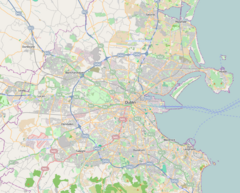Ratra House
| Ratra House | |
|---|---|
 Ratra House in Dublin's Phoenix Park | |
| Alternative names | Little Lodge |
| General information | |
| Status | State residence |
| Type | House |
| Architectural style | Georgian |
| Town or city | Dublin |
| Country | Ireland |
| Coordinates | 53°21′51″N 6°19′18″W / 53.3642°N 6.3216°W |
| Current tenants | Gaisce – The President's Award |
| Estimated completion | c1800 |
| Known for | Former residence of the Private Secretary to the Lord Lieutenant of Ireland |
Ratra House (Irish: Teach Ráth an tSratha),[1] sometimes called Little Ratra, is one of the minor state residences located in the Phoenix Park in Dublin, Ireland.
History
The building, which dates from the early 19th century, was originally known as the Little Lodge.[2]
Residence of the Private Secretary to the Lord Lieutenant
From 1876, it became the official residence of the Private Secretary to the Lord Lieutenant of Ireland, who lived out of season in the next door Viceregal Lodge.[3] Its first resident in this capacity was Lord Randolph Churchill, who was appointed as Private Secretary by the then Lord Lieutenant, his father John Spencer-Churchill, 7th Duke of Marlborough. Churchill lived there with his wife Lady Randolph Churchill and his young son Winston Churchill.[4] Winston Churchill in his writings described his four years, from the ages of two to six, spent in the Little Lodge as among the happiest of his life. It was claimed that he developed his interest in the military from watching military parades at the Lodge.[5]
Offices of the Governor General of the Irish Free State
Following Irish independence in 1922 the house was used for some years by staff of the Governor-General of the Irish Free State before becoming the official residence of Adjutant General of the Irish Army, Major General Brennan between 1926 and 1940.[5]
Residence of Douglas Hyde
In 1945, the wheelchair-using retiring first President of Ireland, Douglas Hyde, was judged too ill to return to his Roscommon country house, Ratra. It was decided instead to move him into the vacant residence in the grounds of the Lodge (then renamed Áras an Uachtaráin).[6] Hyde named the residence Little Ratra in honour of his old home. He died there in 1949.[6]
Irish Civil Defence offices
On 18 June 1951 it became the headquarters of the newly formed Irish Civil Defence and renamed Ratra House. The Irish Civil Defence School was relocated to Roscrea, County Tipperary in 2006,[7] but Ratra House remains in use as an administrative building.[8] Parts of the complex are still used by the Civil Defence, such as the purpose-built training range used by firemen and rescue personnel.[5]
Gaisce - The President's Award
Today, Ratra House is the headquarters of Gaisce – The President's Award.[9]
References
- ^ "Teach Ráth an tSratha / Ratra House". logainm.ie. Irish Placenames Commission. Retrieved 7 November 2018.
- ^ Casey, Christine (2005). Dublin: The City Within the Grand and Royal Canals and the Circular Road with the Phoenix Park. Yale University Press. ISBN 9780300109238.
[Ratra's] construction [..] suggests a date of c.1800 [..] a single-storey canopied veranda supported on slender paired cast-iron colonnettes of mid-C10 appearance, probably of c.1855 [..] It was certainly there in the 1870s when [Churchill took residence]
- ^ Murphy, Brian (2016). Forgotten Patriot: Douglas Hyde and the Foundation of the Irish Presidency. Collins Press. ISBN 9781848895911.
[Ratra House] was the first childhood home that Winston Churchill could remember. In 1876, Churchill's grandfather, the Duke of Marlborough, was appointed as Viceroy to Ireland and he appointed his son, Randolph Churchill, rather of Winston, as his Private Secretary
- ^ "Siblings' illustrated guidebook to Dublin's architectural treasures". irishtimes.com. Irish Times. 20 April 2016. Retrieved 7 November 2018.
Sir Winston Churchill lived in the Phoenix Park when he was a child in the 1870s (in Ratra House, formerly known as Little Lodge). His father, Lord Randolph Churchill, was Private Secretary to his own father, the Duke of Marlborough, then Lord Lieutenant
- ^ a b c "Ratra House – A Brief History". Civil Defence. 4 May 2004. Retrieved 7 November 2018.
- ^ a b Dunleavy, Janet Egleson; Dunleavy, Gareth W (1991). Douglas Hyde: A Maker of Modern Ireland. University of California Press. p. 430. Retrieved 18 June 2011.
- ^ "News - Standing Down Parade at Ratra House, Phoenix Park". civildefence.ie. Civil Defence. Archived from the original on 22 June 2009. Retrieved 7 November 2018.
- ^ "Background - Ratra House - A Brief History". civildefence.ie. Civil Defence. Archived from the original on 22 January 2012.
- ^ "Gaisce - The President's Award - Contact Us". gaisce.ie. Gaisce. Retrieved 7 November 2018.
